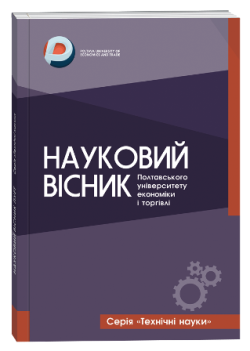TRANSFORMATIONAL IMPACT OF VIRTUAL REALITY TECHNOLOGY ON BUSINESS PROCESSES AND THE SOCIAL SPHERE
Abstract
The article examines the transformative impact of virtual reality (VR) technology on business processes and the social sphere. The main aspects of VR implementation in the corporate sector are considered, including optimizing personnel training processes, improving communication strategies, and increasing marketing efficiency through interactive visualizations. The key advantages of using VR for developing customer-oriented approaches, creating new business models, and expanding market opportunities are analyzed. Particular attention is paid to the impact of VR on the social sphere, in particular education, healthcare, psychological assistance, and inclusion. The role of VR in changing traditional teaching methods through interactive simulations and the ability to model complex situations is determined. It is shown how VR provides a deeper integration of technologies into social processes, contributing to the formation of a new type of interaction between people. The article also analyzes the barriers to VR implementation, including high costs, technical difficulties, and the need for society to adapt to new formats of interaction. The prospects for the development of the technology are presented, which include the creation of full-fledged virtual ecosystems capable of changing traditional models of behavior in both business and social structures. The results of the study demonstrate the significant potential of VR in transforming modern business processes and social practices, which requires further study to form effective strategies for the implementation and use of this technology. Virtual reality technology is one of the immersive technologies that have been demonstrating rapid development and implementation dynamics in various industries in recent years. Together with robotics and network technologies, it is among the three most promising computer technologies. Although less than 100 years have passed since its appearance, virtual reality technology still has many promising opportunities for the development of its theory and practical application. This article is devoted to virtual reality technology and its applications based on an analysis of existing literature, scientific research and statistical data. The main content includes an overview of its advantages, characteristics, technical composition and applications in various industries.
References
2. Crout, Shawneda. (2019). The Importance of Including Interactive Immersive Technology in Instructional Design to Enhance Learner and User Experience. Cornerstone: A Collection of Scholarly and Creative Works for Minnesota State University, Mankato. Retrieved from: https://core.ac.uk/download/225563064.pdf
3. Gopeng (2019). Virtual Reality Technology and Its Applications. Electronic technology & software engineering, (22), p. 128–129.
4. Heryanto, Rachmawati, Aliviya, Kurniya, Tornando, & Hengki (2024). Challenges in Consumer Adaptation to Immersive Technologies: A Comprehensive Literature Review. Komunitas Dosen Indonesia. Retrieved from: https://core.ac.uk/download/617723651.pdf
5. Krodel, T., Krodel, Tim, Schott, Vera. (2023). XR Technology Deployment in Value Creation. MDPI, Retrieved from: https://core.ac.uk/download/581125051.pdf
6. Laukkanen, S., Lauronen, J., Lehto, P., Luimula, M., & Markopoulos, E. (2019). Maritime Safety Education with VR Technology (MarSEVR). The Institute of Electrical and Electronics Engineers (IEEE), Retrieved from: https://core.ac.uk/download/376910602.pdf
7. Lee, M., Lee, S.A., Jeong, M., & Oh, H. (2020). Quality of virtual reality and its impacts on behavioral intention. International Journal of Hospitality Management. Vol. 90. Р. 132–145.
8. Maas, M., & Hughes, J.M. (2020). Virtual, augmented and mixed reality in K-12 education: a review of the literature. Technology, Pedagogy and Education, Vol. 29:2, pp. 231–249. DOI: 10.1080/1475939X.2020.1737210.
9. Oetken, & Michael L. (2024). Using Media Equation Theory to Assess the Effectiveness of Virtual Reality Technology in Organizational Diversity, Equity, Inclusion, and Belonging (DEIB). Training. Scholars Crossing, Retrieved from: https://core.ac.uk/download/614444045.pdf
10. Pellas, N., Mystakidis, S., & Kazanidis, I. (2021). Immersive virtual reality in K-12 and higher education: A systematic review of the last decade scientific literature. Virtual Reality. Vol. 25, pp. 835–861. DOI: 10.1007/s10055-020-00489-9.
11. Połap, D., Kęsik, K., Winnicka, A., & Woźniak, M. (2020). Strengthening the perception of the virtual worlds in a virtual reality environment. ISA Transactions. Vol. 102. P. 397–406.
12. Vasudevan, M., & Unni, Rudresh S. (2023)/ Effect of VR Technological Development in the Age of AI on Business Human Resource Management. 999–1004. doi: 10.1109/ICEARS56392.2023.10085258.
13. Yang, & Zihang. (2019). Advantages and Application Analysis of Virtual Interactive Technology System. Public Communication of Science & Technology (23), 2019, p. 98–99 doi:10.16607/j.cnki.1674-6708.2019.23.051.
14. Zhang, Y., Liu, H., Kang Sh.-Ch., & Al-Hussein. M. (2020). Virtual reality applications for the built environment: Research trends and opportunities. Automation in Construction. Vol. 118. P. 213–239.


